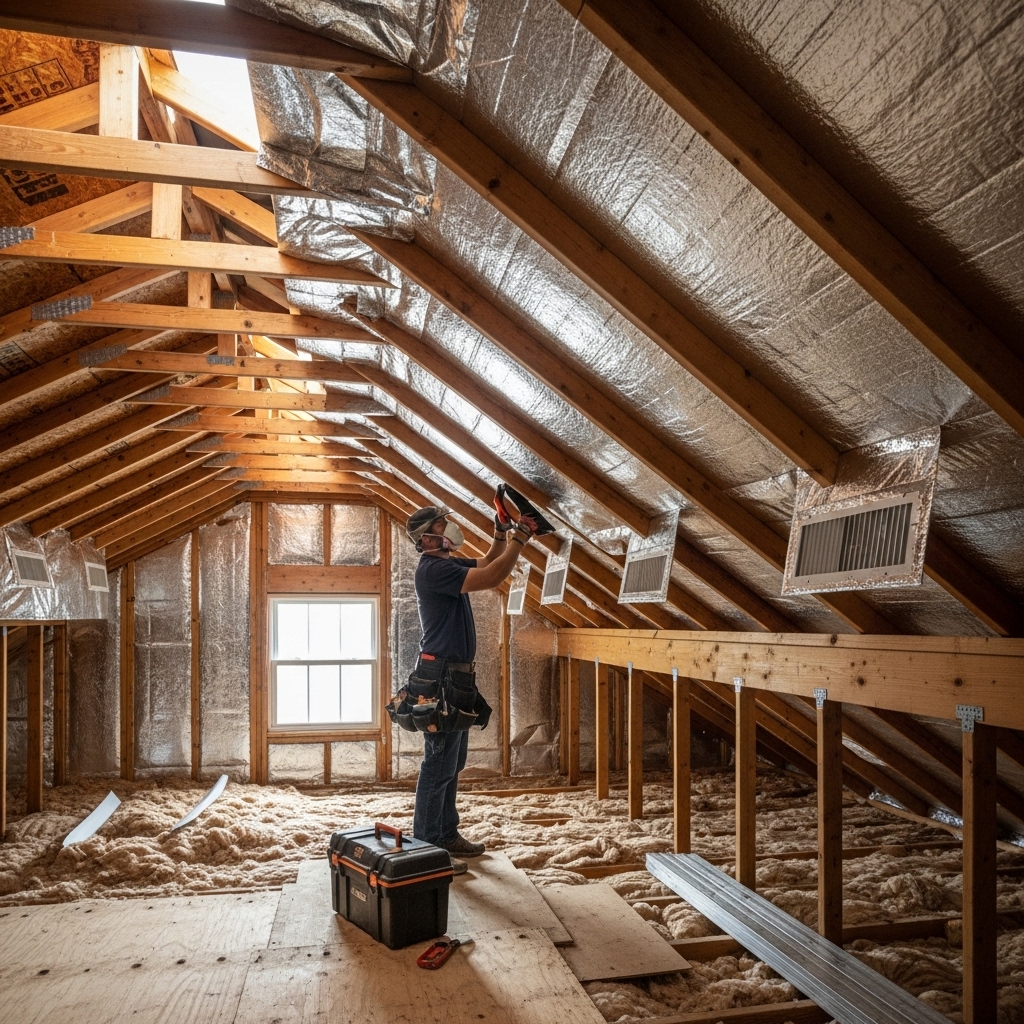What is the best attic insulation for Los Angeles homes? The answer depends on your attic’s geometry, ventilation, and the microclimate around your neighborhood—from coastal marine layer to sun-baked valleys and canyon corridors. Instead of chasing a single “best” material, focus on the combination of product and installation details that keeps heat out, manages moisture, and protects indoor air quality. This guide explains how Los Angeles conditions shape your options and how to pick the approach that delivers real comfort. If you’re beginning your research, remember that a complete solution for attic insulation includes air sealing, balanced ventilation, and clean work practices in addition to the insulation itself.
Choosing wisely means understanding how materials behave in heat, how ventilation supports performance, and which details around eaves, ducts, and fixtures make or break real-world results. With the right plan, your attic becomes a quiet thermal shield that stabilizes indoor temperatures and supports healthier air.
Los Angeles Climate and Attic Performance
LA’s climate brings long stretches of sunny weather, cool nights, and seasonal humidity from marine layers. Roof decks can reach high temperatures on summer afternoons, then shed that heat after sunset. Attics without proper air sealing and ventilation transmit these swings to living spaces below, creating hot rooms by day and drafts at night. The best insulation strategy reduces conductive heat flow while controlling air movement through the attic floor and preserving a steady, well-ventilated roof cavity above.
Core Principles for Selecting Insulation
Regardless of material, successful projects follow several principles:
- Air sealing first: Seal top plates, plumbing stacks, wiring penetrations, open chases, and the attic hatch.
- Balanced ventilation: Provide clear intake at soffits and compatible exhaust to manage heat and moisture.
- Uniform coverage: Avoid gaps and compression, especially at eaves and around obstructions.
- Safe detailing: Respect clearances around recessed lights, flues, and electrical components.
- Duct diligence: Inspect, seal, and support attic ducts to prevent losses that undercut the upgrade.
When these fundamentals are in place, your chosen material performs closer to its labeled value in LA’s real-world conditions.
Material Options in LA: Strengths and Considerations
Each insulation family has strengths that can be leveraged in Los Angeles homes. The best choice fits your attic’s layout and your goals for comfort, acoustics, and long-term maintenance.
Blown-In Fiberglass
Modern blown-in fiberglass resists settling and offers reliable thermal performance. It excels in open attics with truss webs and irregular framing because it can flow around obstacles for even coverage. When paired with strong air sealing and protected eaves, it provides a durable, low-maintenance solution. Installers should use depth markers and avoid compressing the material during movement.
Cellulose
Dense, borate-treated cellulose fills gaps and provides notable sound reduction. Its density can resist some air movement within the layer, especially when installed at proper specifications. In LA, cellulose can be effective in attics where irregular voids and penetrations are common. As with any material, air sealing and eave baffles are crucial to prevent wind-washing and edge losses.
Batt Systems
High-quality batts installed with precision can perform well in targeted areas like knee walls or accessible bays. The challenge is maintaining perfect fit around wiring, plumbing, and framing. In Los Angeles attics with many obstructions, batts may be best reserved for specific applications while blown materials cover open areas.
Roofline Foam (Unvented Assemblies)
Spray foam at the roof deck creates an unvented attic, combining insulation and air sealing. This approach can stabilize temperatures and protect ducts within the conditioned space. It requires experienced crews, careful substrate preparation, and a ventilation strategy for the home as a whole. For some Los Angeles homes, roofline foam is a compelling option when access to the attic floor is limited or when mechanical systems benefit from being inside the thermal boundary.
Radiant Barriers
A radiant barrier under the roof decking can reduce radiant heat gain in sunny climates. Its effectiveness depends on installation quality, clear air spaces, and maintaining balanced attic ventilation. Think of it as a supplemental measure that can enhance performance when integrated into a complete attic strategy.
Special Considerations: Eaves, Soffits, and Wind-Washing
Eaves are the Achilles’ heel of many attics. Without baffles to protect the insulation and maintain intake airflow, wind can scour the edges and rob performance. In LA’s breezy coastal neighborhoods and canyon areas, protecting eaves is especially important. Installers should ensure that coverage remains uniform while preserving clear intake pathways.
Attic Ducts: Amplifying the Benefits
Sealed, supported, and insulated ducts are essential for translating attic improvements into whole-home comfort. Addressing duct leakage during an insulation upgrade prevents conditioned air from escaping into the attic and keeps attic air from being drawn into your living spaces. Duct attention is a high-leverage step that multiplies the value of whichever insulation material you choose.
Indoor Air Quality and Clean Work Practices
Attic work can stir up dust and legacy debris. Quality crews set up containment at the hatch, protect pathways, and use HEPA filtration during removal. They also seal the attic hatch, clean registers after the job, and provide documentation so future work doesn’t undo your improvements.
How to Match Material to Your Attic
Use the following considerations to align your choice with your attic’s needs:
- Complex framing and obstructions: Favor blown materials that flow into tight spaces.
- Need for sound control: Consider denser options and uniform coverage strategies.
- Tight access or multiple mini-attics: Look for methods that minimize movement and allow targeted application.
- Unvented potential: Discuss roofline foam only with experienced teams that can plan ventilation for the whole house.
- Future projects: Choose an approach that’s easy to maintain if you plan lighting or wiring changes.
Ultimately, the “best” system is the one that integrates air sealing, coverage, and ventilation around your attic’s unique geometry.
Comparing Proposals: What to Look For
Evaluate proposals based on completeness and clarity rather than slogans. A reliable plan includes:
- A documented attic assessment with photos.
- Specific air sealing tasks and materials.
- Ventilation adjustments with baffle placement.
- Fixture treatments and safety clearances.
- Coverage strategy to ensure uniform depth.
- Waste handling and cleanup steps.
- Before-and-after documentation and a final walkthrough.
These elements indicate a company that respects building science and your home.
Neighborhood and Home-Style Nuances
LA’s neighborhoods range from beach bungalows with shallow eaves to hillside homes with split levels and modern houses with expansive rooflines. Coastal homes may see more moisture concerns, while valley homes fight higher peak attic temperatures. A thoughtful contractor will adapt material choice and detailing to your neighborhood’s microclimate and your home’s specific layout.
Frequently Asked Questions
Q: Which insulation is best for summer heat?
A: In sunny LA conditions, any material can perform well when combined with strong air sealing, protected eaves, and balanced attic ventilation. Radiant barriers can supplement performance when integrated correctly.
Q: Do I need to remove old insulation?
A: Removal is recommended if material is contaminated, wet, or severely compressed. If existing insulation is clean and dry, augmentation may be possible after thorough air sealing.
Q: Will this help with noise?
A: Yes. Dense materials and uniform coverage can reduce outside noise and room-to-room transmission, making the home quieter overall.
Q: How do recessed lights and chimneys affect the plan?
A: They demand careful detailing, approved covers or clearances, and air sealing around housings to maintain safety and performance.
Q: What role does ventilation play?
A: Ventilation keeps attic conditions stable, supports roofing longevity, and protects insulation from wind-washing—especially important near the eaves.
Q: Can I store items in the attic after the upgrade?
A: Limited storage may be possible with raised platforms or catwalks that prevent compression. Discuss plans with your contractor so storage doesn’t undermine coverage.
Plan the Best Solution for Your LA Home
The best attic insulation for Los Angeles is the one that pairs the right material with careful air sealing, balanced ventilation, and uniform coverage tailored to your attic’s geometry. Choose a company that documents its work, explains the “why” behind each step, and respects your home with clean practices. When you’re ready to explore options and schedule an assessment, reach out to a team that treats attic insulation as part of a whole-home strategy and provides clear guidance from inspection to aftercare. With the right plan and partner, your attic will quietly support year-round comfort and healthier indoor air.

